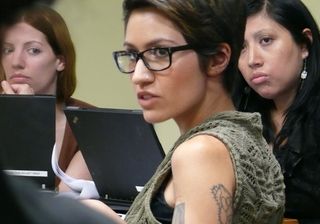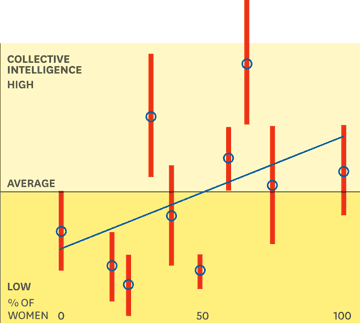By Dr. Ken Broda Bahm –  “The men totally dominated the discussion the last time,” said JoAnn Chiakulas, the hold-out juror in Rod Blagojevich’s first corruption trial, “and a lot of the women were not treated very nicely.” The former governor’s newer jury consisted of eleven women and one man you might expect a change in that department. But this second jury deliberated for nine days before finding the former Illinois Governor guilty on 17 out of 20 counts. Why did it take so long? The temptation is to say, “well, it is probably because of the one man.” And some current research backs that up. Woolley and Malone (2011) assessed the performance of groups, originally looking at the role of the IQ levels of group members as a predictor of better group performance. What they found is that groups with higher numbers of smarter individuals didn’t do better, but groups with more women did: consistently, and the more women the better. In the past, we’ve warned against basing your strikes on demographic assumptions, and that remains good advice. There is no evidence from this or prior studies that a juror’s gender will reliably predict a verdict. But the implication of the Woolley and Malone research on group intelligence is that the concentration of women in a group may well predict the process that jury takes. This post takes a look at this research in the context of the female-dominated Blagojevich jury, and makes specific recommendations for litigators who are thinking about gender in a jury context.
“The men totally dominated the discussion the last time,” said JoAnn Chiakulas, the hold-out juror in Rod Blagojevich’s first corruption trial, “and a lot of the women were not treated very nicely.” The former governor’s newer jury consisted of eleven women and one man you might expect a change in that department. But this second jury deliberated for nine days before finding the former Illinois Governor guilty on 17 out of 20 counts. Why did it take so long? The temptation is to say, “well, it is probably because of the one man.” And some current research backs that up. Woolley and Malone (2011) assessed the performance of groups, originally looking at the role of the IQ levels of group members as a predictor of better group performance. What they found is that groups with higher numbers of smarter individuals didn’t do better, but groups with more women did: consistently, and the more women the better. In the past, we’ve warned against basing your strikes on demographic assumptions, and that remains good advice. There is no evidence from this or prior studies that a juror’s gender will reliably predict a verdict. But the implication of the Woolley and Malone research on group intelligence is that the concentration of women in a group may well predict the process that jury takes. This post takes a look at this research in the context of the female-dominated Blagojevich jury, and makes specific recommendations for litigators who are thinking about gender in a jury context.
The Research
First, a little more on the study. As reported in an article and audio interview in in The Harvard Business Review, professors Anita Woolley of Carnegie Mellon University and Thomas Malone of Massachusetts Institute of Technology look at the unique concept of “group intelligence,” as distinct from the combined intelligence levels of individual members. Putting groups of males and females together and assigning tasks where success could be measured, the researchers found that group success had only a very low correlation with the intelligence levels of its individual members. But the unexpected finding was a high and linear correlation between group success and the number of women in the group. This chart shows the performance of 192 teams in the study, with the X-axis showing the percentage of women and the Y-axis showing the group’s collective intelligence. As the percentage of women rises, the teams’ average scores (blue circles) and range of scores (red bars) rises.  Why would that be the case? That remains the focus of further research, but the belief so far is that the greater concentrations of women cause the group to interact differently. Males, whether intelligent or not, will often try to dominate discussions, but women are more likely to listen and to work together. As professor Woolley explained, “Having more women in a group actually seems to change group process in some fairly beneficial ways. So groups usually experience higher quality collaboration.”
Why would that be the case? That remains the focus of further research, but the belief so far is that the greater concentrations of women cause the group to interact differently. Males, whether intelligent or not, will often try to dominate discussions, but women are more likely to listen and to work together. As professor Woolley explained, “Having more women in a group actually seems to change group process in some fairly beneficial ways. So groups usually experience higher quality collaboration.”
Blagojevich Jury, Take Two
We might see this difference in a different context by comparing the two Blagojevich juries. While we will definitely know more when and if we are able to talk to the second jury post-verdict, this research gives us a reason to form some theories about what may be going on. Blagojevich’s defense depended on a jury getting past what many call the obvious (tapes with fairly clear talk about trading favors for money), in order to take a closer look at the nuances of intent.
In that context, the defense probably welcomed the gender change in the second jury. As consultant Howard Varinsky commented, “Men just say, ‘To hell with them,’… Guys are just quicker to condemn.” The President of the American Society of Trial Consultants, Beth Foley, further argued that women are more likely to spend time examining the “whys” of a case, and to take a closer look at intent. Foley further noted, “A woman might ask what was Blagojevich thinking, while a man might say, I need to know the facts — I don’t care what he was thinking.” While Mr. Blagojevich’s legal team should not have expected women to like their client more, or to have a softer view on bribery, they were on firm ground in thinking that that a group of women is a little more likely to have higher social intelligence and encourage a more thorough, respectful and inclusive discussion.
Did it work? According to juror Rosemary Bennett, “We got along really well. There were a couple people that were hung (on a verdict), but both sides were very considerate of each other.” This time, that didn’t translate into exoneration for the governor, and maybe the defense would have been better off with another pool of argumentative men and another hung jury. But in the long-run, parties that have an interest in thorough and productive deliberations should consider their jury’s social intelligence.
So How Do You Assess Social Intelligence?
For litigators, the practical question is always, “okay, so what do I do with this information in court?” First off, there are a couple of things you probably can’t do. One, you are unlikely to be able to measure group smarts directly on a jury. The researchers talk about future tools that would specifically chart collective intelligence, and while we can imagine the benefits of applying that to a formed jury, it would take an enormously tolerant judge to allow that. Two, you can’t — or shouldn’t — just strike men when you want the more socially intelligent jury. Not only does the U.S. Supreme Court consider that a no-no (see J.E.B. v. Alabama ex rel T.B., 511 U.S. 127, 1994), but it is never a good idea to let a single demographic trait trump our larger interest in the attitudes and decision-making styles of your jurors and jury. So what should you do? I’d say there are four good practical implications from this research.
1) Diversity your trial teams.
In the past couple of decades, the number of female litigators has increased as the practice of law has become more diverse. Despite that broadening, though, how often in high stakes litigation, does preparation within the team boil down to a group of guys making the important decisions? You should add gender diversity to your team not to impress the jury with your inclusiveness, but to improve the quality of your team’s decision-making.
2) Think of your jury as a group, not just as individuals.
Remember that a jury’s verdict is not a sum or an average of individual decisions, it is a group decision. The voir dire process encourages a juror-by-juror approach, and you don’t even know the composition of the jury until the end of selection. But an important part of the chess-game thinking in that context is to ask, “what may be the effects of my individual strikes, and the other party’s likely strikes, on group composition as a whole?” Once the jury is formed, it is important to think about how it will function, who the more social and engaged members will be, and who is likely to emerge as a leader.
3) Don’t equate intelligence with leadership.
It is tempting to look at the smartest, most educated member of the panel, or the one with the highest-status occupation, and say, “there is my foreperson.” That will sometimes be the case and sometimes not. We know that intelligence and leadership are two different things, and we also know that intelligence is many things. Abstract smarts, or intelligence on the job, doesn’t always translate to intelligence in leading or facilitating a group.
4) Look for signs of social intelligence.
When your side of the case is likely to require harder work from your jury, you’ll be looking for a group able to work well togther and willing to prioritize that process over an impulse decision. This study notwithstanding, that isn’t necessarily a jury with more women. As Dr. Woolley notes, “what is really important is to have people who are high in social sensitivity, whether they are men or women.” How do we identify those people beyond looking at gender? Look at potential jurors who are having conversations with multiple other panelists rather than sitting silently by themselves. There are also questions that can be developed from academic scales looking at social sensitivity. We will also be looking for Woolley and her colleagues to tell us more about how to identify and adapt to group intelligence as this concept is refined in the future.
But for now, the research — both method and result — can be summarized by Harry Belafonte (how often does that happen?). As his Calypso cover of the classic Man Smart, Woman Smarter, concludes: “That’s right, the women are smarter.” At least as far as group intelligence goes — arguably the most important kind of intelligence to a jury — Belafonte seems to have gotten it right.
_____ Related Posts:
- Be Relatively Cautious With Absolutist Jurors
- Don’t Count on Gender Differences When it Comes to Compassion
_____ Note that the research reported in HBR appears to be as yet unpublished working paper. The following citation is an earlier study in the same research program.  Woolley AW, Chabris CF, Pentland A, Hashmi N, & Malone TW (2010). Evidence for a collective intelligence factor in the performance of human groups. Science (New York, N.Y.), 330(6004), 686-8 PMID: 20929725 Photo Credit: WeNews, Flickr Creative Commons
Woolley AW, Chabris CF, Pentland A, Hashmi N, & Malone TW (2010). Evidence for a collective intelligence factor in the performance of human groups. Science (New York, N.Y.), 330(6004), 686-8 PMID: 20929725 Photo Credit: WeNews, Flickr Creative Commons